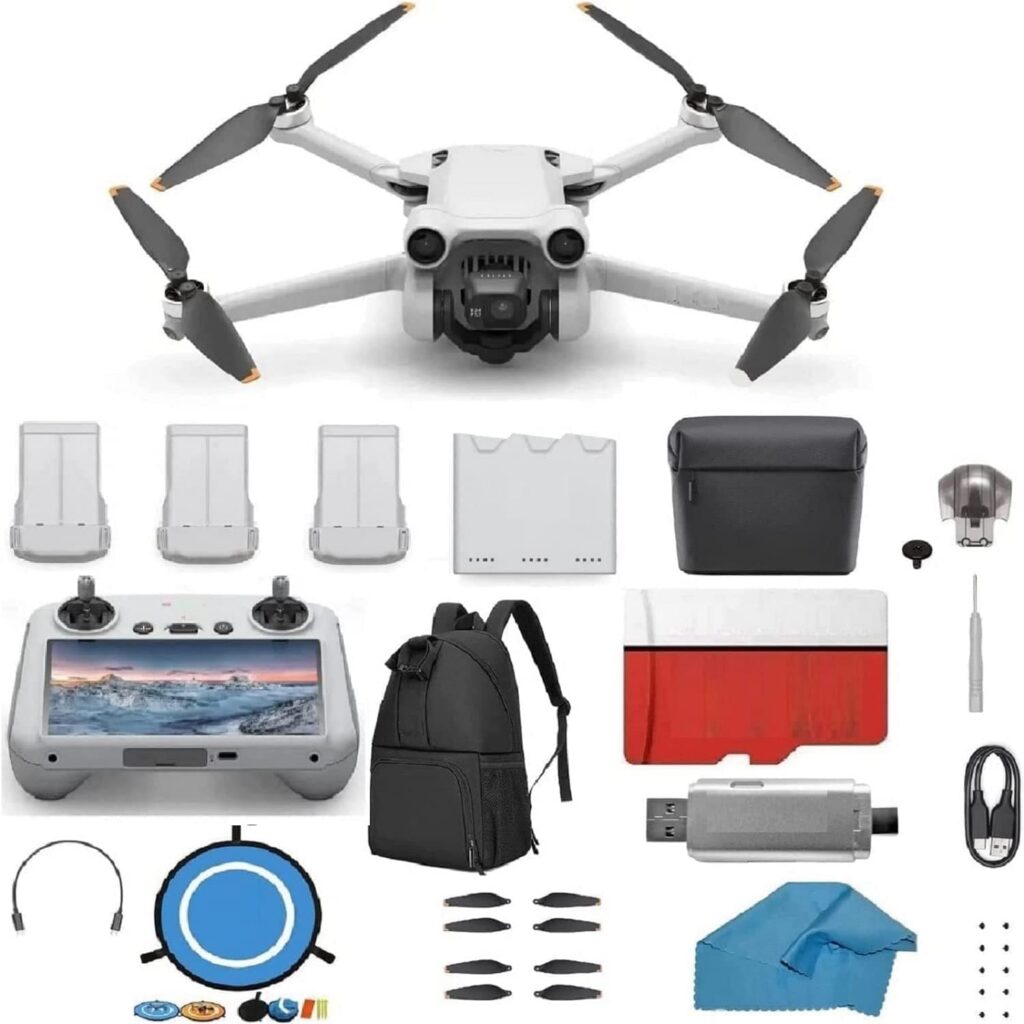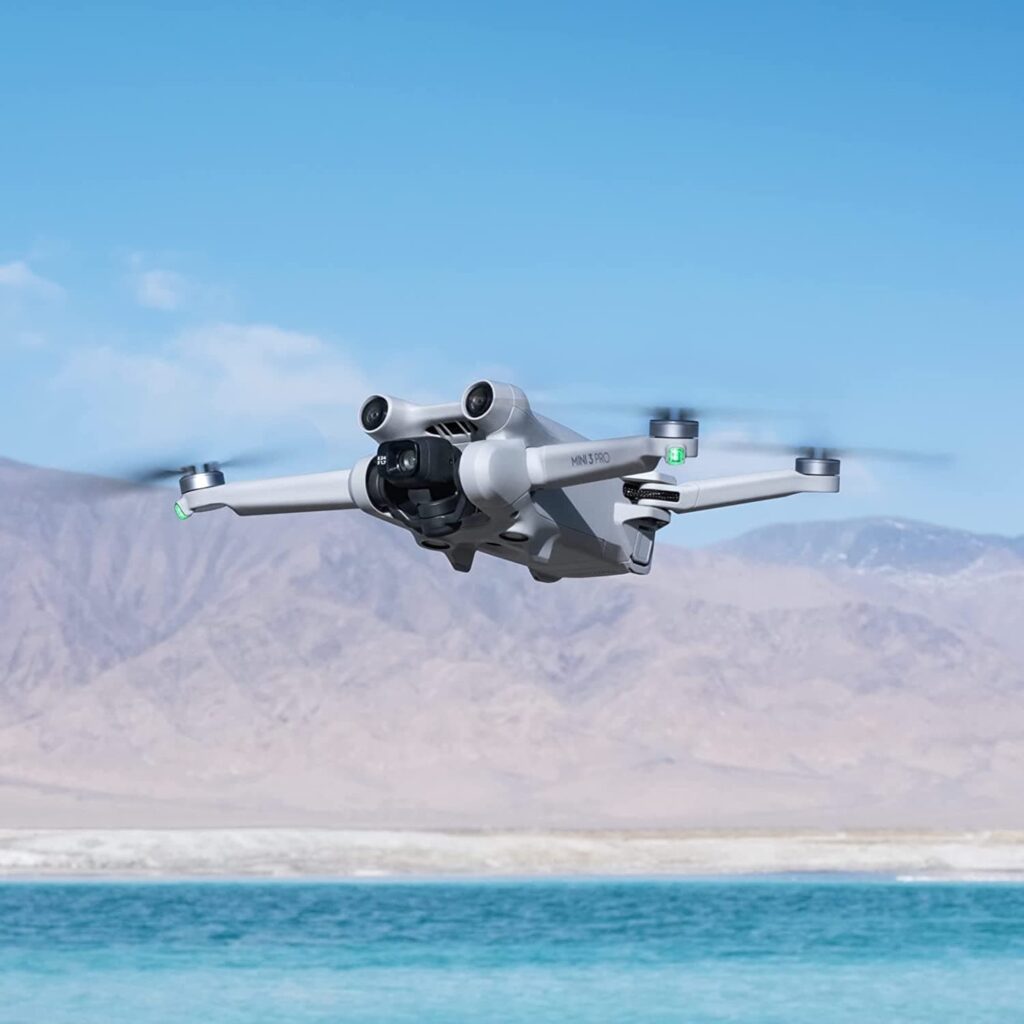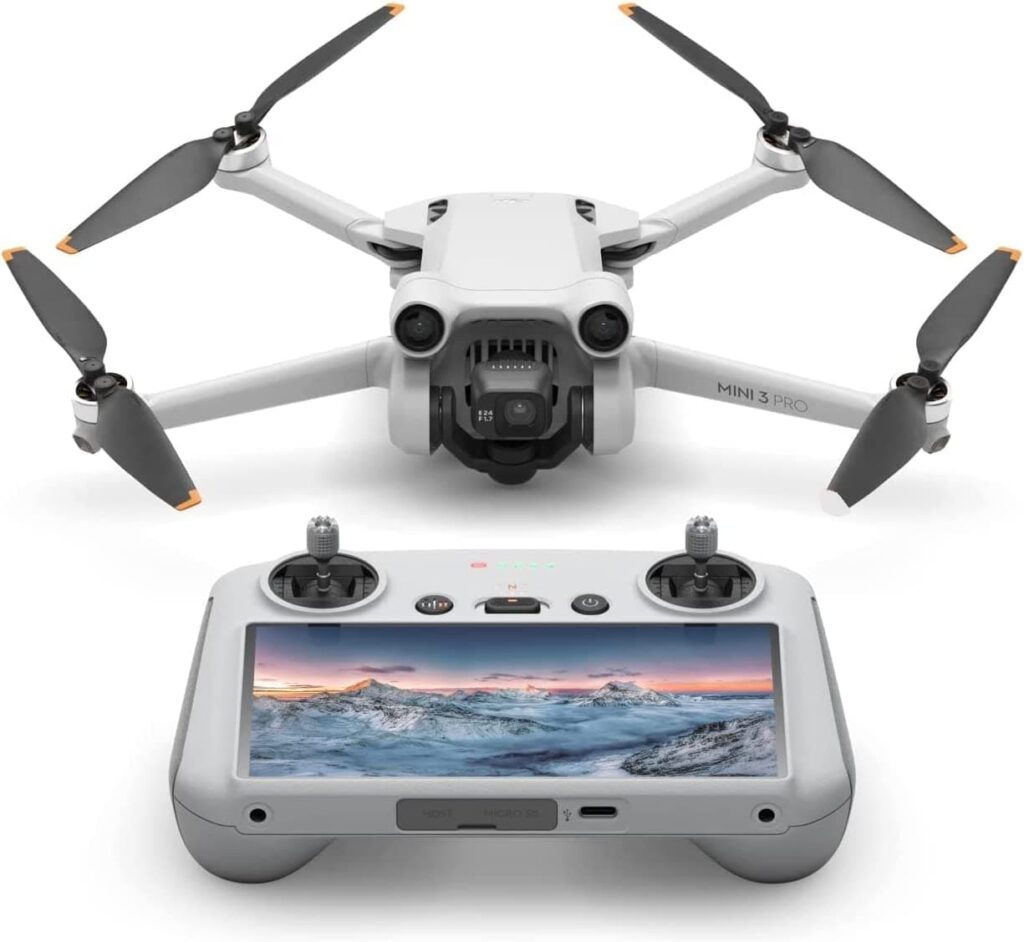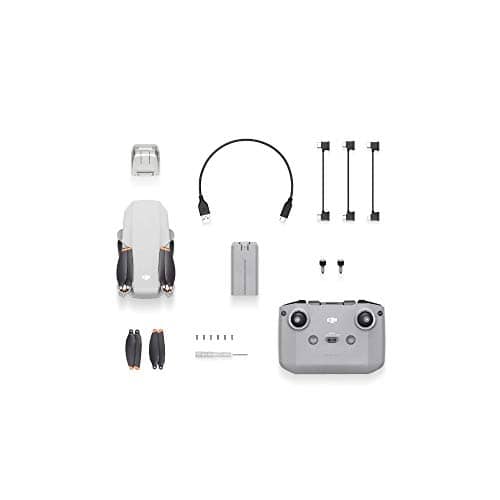DJI Mini 3 Pro – The 4K mini drone for beginners AND professionals
The DJI Mini 3 Pro comes up with a whole range of innovations and combines professional equipment with low weight (249 grams). The highlights of the high-end mini drone include a 90° rotatable 4K camera with 60 fps, obstacle detection in three directions and the FocusTrack mode, which is now finally available for a “Mini”.
Available in 3 versions: Standard Combo, RC Combo, Stand Alone
The DJI Mini 3 Pro is available in three different versions. You can choose between the Standard Combo (approx. $ 759), the DJI RC Combo (approx. $ 909) and, now brand new from DJI, the Stand Alone version without remote control (approx. $ 775).
The latter version is especially recommended if you already own a DJI drone with RC-N1 controller (Air 2S, Air 2, Mavic 3, Mini 2). While the Standard Combo comes with the normal remote control (RC-N1), the RC Combo includes the new RC controller with integrated display (no smartphone needed).
The Standard Combo and the DJI RC Combo can also be combined with the Fly More Kit (+ ca. $ 150). The kit provides an additional carrying case, two more batteries, a multi-charging station, four additional propellers and an extra USB-C cable (USB 3.0).

DJI Mini 3 Pro vs. DJI Mini 2: What’s new?

The DJI Mini 3 Pro comes up with a whole series of innovations. The most noticeable are the aerodynamically revised housing and the slightly larger propellers.
But DJI hasn’t just made changes to the chassis. On the contrary, the biggest changes to the previous version are found inside the small camera drone. The most notable changes are the improved camera, which can now record 4K footage at up to 60 fps, as well as the revised gimbal with a larger rotation range and the ability to tilt the camera 90° to create true vertical shots.
The portrait video feature will especially please those who regularly want to create videos for social media platforms like Instagram, TikTok or YouTube shorts.
Another highlight of the DJI Mini 3 Pro is the obstacle detection, previously only known from the Pro models, with sensors on the front, back and bottom of the drone. Thanks to this innovation, FocusTrack object and people tracking is finally available. FocusTrack includes ActiveTrack, Spotlight and Point of Interest modes.
Those who opt for the RC Combo will also receive the new RC controller with built-in 5.5″ display.
Design and weight
While the color of the copter has not changed compared to the previous versions, the general design of the housing, however, shows some innovations. Most notable here is the redesigned front of the drone, which now features two obstacle detection sensors on the left and right above the main camera, giving the Mini 3 Pro an insect-like appearance.
The shape of the Mini drone’s two front arms has also changed slightly. They are now a bit longer and each have a signal LED at their ends. The front landing feet, which were still attached directly to the front booms on the DJI Mini 2, are now found directly on the bottom of the body. This results in a greater distance between the ground and the propellers, providing improved protection for the rotors from branches or stones on uneven surfaces.
Tip: To protect your drone even better during takeoff and landing, we generally recommend the purchase of a drone landing pad.
As with the DJI Mini 2, the installed rotors are unfortunately not the practical quick-release propellers. Therefore, a screwdriver is always needed for replacement (included). Unlike its predecessor, however, the Mini 3 Pro’s propellers are slightly larger. This has a positive effect on both the flight behavior and the volume.

The new folding mechanism of the Mini 3 Pro might take some getting used to for many Mini 2 owners. The front arms are now rotated downwards and the rear arms are unfolded sideways – exactly the opposite of the Mini 2. However, this also has a huge advantage: all four arms can now be unfolded in any order – very good!
The battery compartment has also been redesigned. It is no longer closed with a flap, but the battery itself forms the outer closure – as you are already used to from the Mavic 3, DJI FPV or Phantom 4. Two new side vents also ensure efficient cooling of the battery.
We also really like the new placement of the on/off button, which has been moved from the bottom to the top, making it much more convenient to reach.
The weight of the DJI Mini 3 Pro, including battery and inserted microSD card, is only 249 grams. This means that you neither need to register the drone with the FAA nor is there a need for a Remote ID complaint. When flying in Europe you do not need the small or the large EU drone license for proper operation.
Speed and flight characteristics
As usual with DJI, you can again choose between a total of three different speeds or flight modes with the Mini 3 Pro: Cine, Normal and Sport.
In Cine mode, you have the greatest possible control over the drone. The Mini 3 Pro responds to control commands in this mode just as promptly as in the other modes. However, speed (max. 13.4 mph or 21,6 km/h) and acceleration are throttled. This allows for particularly smooth flight maneuvers and steady camera movements.
In Nomal mode, the drone reaches a maximum of 22.4 mph (36 km/h), while up to 35.8 mph (57.6 km/h) is possible in Sport mode.
Thanks to the built-in GPS module, which can also communicate with Galileo and BeiDou satellites, the Mini 3 Pro holds its position extremely precisely and exhibits very good wind stability (up to about 24 mph (39 km/h)).
By the way, if you were hoping to fly the new Mini 3 with either the DJI Goggles or the DJI Googles V2, you will unfortunately be disappointed. Both FPV goggles are currently not compatible with the Mini 3 Pro. It is not yet clear whether this will change.
The controllers: DJI RC-N1 or DJI RC

Depending on which version of the DJI Mini 3 you choose, you will receive either the DJI RC-N1 controller or the new DJI RC remote control. The RC-N1 controller is the same one that came with the Air 2S, Air 2, Mavic 3 and Mini 2.
As is common with almost all other drones, the RC-N1 allows a smartphone including the DJI Fly app to be attached in the retractable cradle mechanism. Using the new RC controller, on the other hand, does not require a smartphone, as the controller has a built-in 5.5″ display.
Its display has a touchscreen with a Full HD resolution of 1080p at 30fps and delivers a sharp and high-contrast image even in direct sunlight. We also like the fact that the remote control has its own microSD card slot to transfer photos and videos from the drone to the controller for immediate viewing.
On the back of the controller, there are also two freely programmable buttons (C1 and C2) that are easy to reach. This way, frequently used functions such as switching between landscape and portrait mode or realigning the gimbal can be performed with just one press of a button.
Both controllers feature DJI’s advanced O3 (OcuSync 3.0) video transmission system, which provides a stable 1080p video stream at 30 fps up to distances of approximately 7.5 miles or 12 km (FCC) or 5 miles or 8 km (CE). The video bit rate of the data transmission between the drone and the controller is 18 Mbps with a latency of only 120 ms.
By the way, the RC controller can also be used with the Mavic 3 Pro. Whether this will also be the case with other models in the future is not yet clear.
Obstacle detection
A special highlight of the DJI Mini 3 Pro is certainly the new obstacle detection system, with sensors on the front, back and bottom. Thanks to APAS 4.0 (advanced pilot assistance system), the drone not only detects obstacles at a distance of up to 27 yards, but can also actively avoid them.
Incidentally, the anti-collision system also works in RTH mode, ensuring even greater safety during the automatic return flight to the launch position. The range of obstacle detection is up to 27 yards to the front, 25.6 yards to the rear and a maximum of 9.8 yards downward.
Not available when shooting in: 4K/48fps, 4K/50fps, 4K/60fps, 2.7K/48fps, 2.7K/50fps, 2.7K/60fps and 1080p/120fps.

Flight time and range of the DJI Mini 3 Pro
The flight time of the DJI Mini 3 Pro is up to 34 minutes per battery charge. This is an extremely good value, which is again 3 minutes longer than the maximum flight time of the DJI Mini 2. This is made possible by a 7.38 V, 2453 mAh Li-Ion battery.
Those who already own a DJI Mini 2 will probably wonder if their batteries are compatible with the new Mini 3 Pro. Unfortunately, this is not the case. The new batteries have a different shape. Therefore, it is also not possible to use the DJI Mini 3 Pro batteries in the Mini 2.
The maximum control range of the drone is up to 7.5 miles or 12 km in the US (FCC). In Europe (CE) a maximum of 5 miles or 8 km is possible. At altitude, up to 4375 feet are possible. However, keep in mind that drones in many countries may only be flown within visual range. However, a high maximum range also means a very stable control and video signal at shorter distances at the same time, which has a positive effect on flights in environments with obstacles such as trees or buildings, among other things.
Another practical feature of the new charging station is that it can also be used as a power bank to charge other electronic devices.
Camera and gimbal of the DJI Mini 3 Pro

Some of the most important innovations of the DJI Mini 3 Pro can definitely be found in the camera and gimbal. The new 1/1.3″ CMOS sensor with dual-native ISO (100 and 500) is slightly larger than in the Mini 2 and, together with the fixed aperture of f/1.7, enables better low-light performance.
Even though the aperture cannot be adjusted, shutter speed, ISO and white balance can be freely selected in the app at any time. The camera’s equivalent focal length is 24 mm and the field of view (FOV) is 82.1°. The maximum bit rate of 150 Mbit/s is a full 50% higher than on the Mini 2 and ensures extremely high-quality videos.
The maximum video resolution is 4K (3840 x 2160 pixels) at 60 fps. Those who want to create HDR videos can do so in all resolutions up to a maximum of 30 fps.
Particularly ambitious hobby filmmakers will also be pleased to now have the choice between two different color profiles: Normal or D-Cinelike. The latter provides more freedom in post-processing and makes it possible to create professional-looking video sequences that were previously not possible with a “Mini”.
All video resolutions
- 4K: 3840×2160 at 24/25/30/48/50/60 fps
- 2.7K: 2720×1530 at 24/25/30/48/50/60 fps
- Full HD: 1920×1080 at 24/25/30/48/50/60 fps
- Slow motion: 1920×1080 at 120 fps
In general, the Mini 3 Pro shows crisp, high-contrast video at all resolutions, with little noticeable difference from the quality of a DJI Mavic 3.
One of the biggest new features of the Mini 3 Pro is certainly the ability to tilt the 3-axis mechanical gimbal 90° to capture photos and videos in portrait mode. This will especially please those who want to shoot portrait videos for social media platforms.
Photos can be taken with the DJI Mini 3 Pro in either 12 or even 48 megapixels. As usual, you can choose between JPEG or DNG (RAW) format. Even at 12 MP, the pictures already look extremely good, so the 48 MP mode only really needs to be selected if you want to print photos extremely large afterwards.
Your pictures are stored either in the internal memory (1.2 GB) or on a 64 to 512 GB memory card (not included).
Intelligent flight and recording modes
Quickshots
In addition to the quickshots already known from the Mini 2, Dronie, Helix, Rocket, Circles and Boomerang, the Mini 3 Pro now also masters the ever-popular Asteroid mode.
In Asteroid mode, the drone moves away from a pre-determined object or person and flies backwards in a steep curve towards the sky. There, it then records a spherical panorama that simulates a kind of globe. If the video is then played backwards, the shot resembles the view from a hypothetical asteroid approaching the Earth.
MasterShots
With the MasterShots function, you can have a series of shots of a previously selected object taken fully automatically. The drone automatically performs suitable flight maneuvers and records the scene from different angles and with different flight maneuvers.
A video can be created from the individual sequences afterwards in the app. In addition, individual templates (image and sound effects) can be used to create videos that previously could only be edited with a lot of work on the PC.
FocusTrack
One of DJI’s most popular shooting modes is undoubtedly FocusTrack. Unfortunately, due to the lack of obstacle sensors, this feature was not available in the DJI Mini 2. However, since the Mini 3 Pro now has an obstacle detection system, the mode is now available and allows you to track people or objects while avoiding obstacles.
FocusTrack is divided into the sub-modes ActiveTrack 4.0, Spotlight 2.0 and Point of Interest 3.0.
In Spotlight mode, the camera always follows the selection, while you can still maneuver the drone freely to capture different angles of view.
In ActiveTrack, the drone independently follows objects or people, either laterally (Parallel) or from behind (Trace). In doing so, the drone does not lose sight of the selection, even if obstacles briefly obscure the view.
With the Point of Interest function, the Mini 3 Pro can circle an object or person in a freely adjustable radius and simultaneously record a video. Speed and direction of rotation can be selected individually.
Please note that FocusTrack is not available when shooting in 4K/48fps, 4K/50fps, 4K/60fps, 2.7K/48fps, 2.7K/50fps, 2.7K/60fps and 1080p/120fps.
Hyperlapse
Also new to the DJI Mini 3 Pro is Hyperlapse mode, previously only known from larger drone models. It allows you to capture time-lapse footage (timelapse) and is broken down into four individual sub-modes (Free, Circle, CourseLock and Waypoint).
While Free mode gives you full control while shooting, Circle mode lets the drone fly on a pre-determined circular path. CourseLock lets the Mini 3 Pro fly in a straight line, and the Waypoint function lets you set a specific flight path in advance.
What we particularly like about the Waypoint mode is that the Mini 3 Pro remembers the individual waypoints. This allows you to create an exact copy of the hyperlapse flight at a later time. This can be exciting, for example, if you want to film a landscape once during the day and once at night.
You can also set the desired length of the Hyperlapse sequence, the speed of the drone during the flight, and the interval at which the individual shots should be recorded.
By the way, the Hyperlapse mode also works when shooting in portrait format.
Panorama
In Panorama mode, you can choose between four different shooting modes: wide-angle, 180°, vertical and spherical panorama.
Scope of delivery
No matter which version of the DJI Mini 3 Pro you choose, the following components are included in each version:
- 1 x DJI Mini 3 Pro drone
- 1 x Li-Ion battery (7.38 V, 2453 mAh)
- 3 x connection cables to the smartphone (microUSB, USB-C, Lightning)
- 1 x USB-C charging cable
- 4 x replacement propellers
- 1 x gimbal protection cap
- 1 x Screwdriver and spare screws
If you choose the Standard Combo, you will also receive the DJI RC-N1 remote control. If you choose the RC Combo, you will receive the new DJI RC remote control instead of the DJI RC-N1.
If you also decide to purchase the Fly More Kit, you will also get a carrying case, additional propellers, a multi-charging station, and two additional batteries.

Conclusion
The DJI Mini 3 Pro is currently probably the best mini drone with camera on the market. It combines low weight (and thus fewer legal constraints) with sophisticated recording technology, excellent flight performance and ease of use.
Like its two predecessors, the Mavic Mini and Mini 2, the Mini 3 Pro sets new standards in the consumer drone sector. In addition to the revised design, the main new features compared to the Mini 2 are the FocusTrack mode (ActiveTrack 4.0, Spotlight 2.0 and POI 3.0), which is now finally available, the ability to record 4K footage at 60 fps, a 90° swiveling gimbal that enables the recording of upright videos, and obstacle detection.
The flight time has also been extended once again with up to 34 minutes, and thanks to larger propellers, the DJI Mini 3 Pro has not only become a bit quieter, but also features further improved flight characteristics for particularly smooth and steady flights.
Thanks to the wide range of shooting modes and the very user-friendly DJI Fly app, the DJI Mini 3 Pro can be easily operated even by absolute beginners. Modes like the QuickShots and MasterShots allow even drone novices to capture unique video sequences from different perspectives.
Thanks to the excellent camera and the first-class gimbal, video recordings not only shine in brilliant colors and razor-sharp resolution, but are also extremely smooth and free of shakiness.
Only the lack of compatibility with the Mini 2’s batteries and the DJI Goggles are minor minus points. Overall, DJI definitely delivers one of the most interesting drones currently available with the Mini 3 Pro.
We can therefore highly recommend the DJI Mini 3 Pro and wish you a lot of fun flying and filming!


